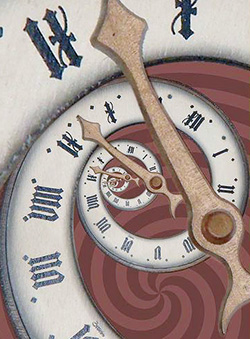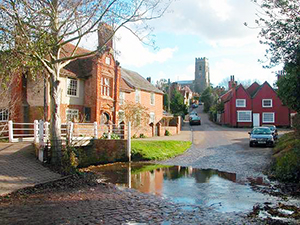 The Evidence for Time Travel By HERBIE BRENNAN
The Evidence for Time Travel By HERBIE BRENNAN
My first non-fiction book on time travel came about wholly by accident. I was interested in trying to discover whether or not there was much hard evidence for the sort of Ice Age civilisation mentioned by Plato in his account of Atlantis and also what level of technology such a civilisation might have achieved. I thought if there was something positive in this, it might make an interesting book.
Since the postulate of an Ice Age civilisation is obviously linked to the evolutionary pattern of humanity, I began my research there – specifically attempting to find evidence of civilised activity prior to the establishment of the Sumarian state widely accepted as the starting point of modern culture. As civilisations take time to develop, I was also searching for evidence that humanity’s appearance on the planet might have been earlier than generally supposed.
While conducting this research, I did indeed find archaeological evidence which suggested that Homo sapiens evolved earlier than the orthodox text books claim. At first these finds were manageable – they pushed back the appearance of humanity some tens of thousands of years. But then came the shock. There was a record of a find that suggested humanity was on the planet not thousands, but millions of years earlier than the time established by the orthodox scientific consensus.
At first I thought this find might be a fake, or a misinterpretation. But as my research continued, it became clear the find was not unique. There were many, many archaeological discoveries that pointed to an early evolution of humanity. Individually, these seem to have been dismissed as oddities, or simply ignored, by the scientific establishment, but the sheer weight of evidence seemed to me to suggest the finds needed an explanation.
At this point, I still thought I was looking at evidence for the early emergence of humanity. Then I came across records of discoveries that pointed to the appearance of humans at a ridiculously early period – contemporary with and even earlier than the dinosaurs. Since this was manifestly impossible (the mammalian line itself hadn’t evolved at this time) I suddenly realised the evidence had to point somewhere else. I considered the alternatives and the only half sensible explanation I could come up with was that the finds were litter left by time travellers.
On the face of it, this seemed highly unlikely, but I was curious enough to want to know what modern physics said about the theoretical possibility of time travel. So I started research there and discovered that while Newtonian physics neither supported nor denied the possibility of time travel, both Relativity Theory and Quantum Mechanics seemed to say it was possible. One respected physicist had actually published plans for a (theoretical) time machine!
At that point, I (temporarily) abandoned my book on the Ice Age civilisation and started seriously to move in a wholly different direction. Time Travel: A New Perspective was the result, a thorough study of the theme, published by Llewellyn in the United States. I returned to the theme in a second book aimed at a young adult audience and entitled simply Time Travel which has now been published in the UK by Faber and Faber as part of my Herbie Brennan’s Forbidden Truths series.
So what was the evidence that started all this?
The find that originally sparked my interest was the Transvaal spheres. Several hundred metal balls – some of them spookily like cricket balls – have been found by miners in the Western Transvaal, near the town of Ottosdal. They look manufactured and the metal seems to be toughened steel. But they’re still being unearthed from a Pre-Cambrian sediment, which means they have to be 2,800 million years old.
Who dropped them? Not contemporary humans, that’s for sure. The earliest dinosaur hadn’t even appeared at that time. Manufactured objects in the Pre-Cambrian era are a glaring anachronism. And not the only one I came across.
There was a polished concrete block wall found in the depths of an Oklahoma coal mine and estimated to be 286 million years old, a delicate gold chain of similar vintage found in Illinois, a carved stone found in Iowa that was dropped some 260 million years before humanity evolved on the planet, and many more, including a decorated metal vase from Massachusetts more than 600 million years old.
There are very few possible explanations for finds of this type. One is that they are simply misdated – the dismissive ‘explanation’ put forward by orthodox archaeologists. But it’s difficult to see how you can misdate something like the Massachusetts vase that was actually discovered encased in solid rock.
Another possibility is that the artifacts were dropped by visitors from space. The Ancient Astronauts Theory is no longer as popular as it once was, killed off by sensationalist claims and some blatant tweaking of the ‘evidence.’ All the same, most scientists are agreed that life must exist elsewhere in the universe and some of it may be intelligent. Which means that, long shot though it might be, the transport of some alien civilisation might have docked on Earth at the dawn of time and discharged metallic ballast in an area that eventually became the Transvaal.
But even if the South African spheres turn out to be of alien manufacture (or some sort of weird natural phenomena, for that matter) several other anachronistic artifacts are undoubted human in origin. The carved stone from Iowa, for example, features multiple representations of an old man’s face. There was a fossilised human shoe print found in Utah shale some 500 million years old. A human footprint was discovered in Turkmenistan in Central Asia, next to that of a three-toed dinosaur.
The dinosaurs disappeared from our planet, quite suddenly, some 65 million years ago. Until that happened, the most advanced mammal on the face of the globe was a little tree-dweller the size of a mouse. Humanity is supposed to have evolved in Africa some 100,000 years ago – and while there may be a case for adjusting this date backwards, nobody suggests we could have walked the Earth in the days of the dinosaurs.
Finds like these got me thinking along the lines of time travel, but failed to convince me. At the time, I assumed modern scientific thought dismissed the possibility as nonsense. This assumption, however, turned out to be wrong.
Surprisingly, Newtonian physics – the practical stuff that underlies almost every example of modern technology – doesn’t deny the possibility of time travel. Newton’s Second Law of motion states that ‘the time rate of change of the velocity or acceleration of a body is directly proportional to the force applied and inversely proportional to the mass of the body.’ In the mathematical expression of this Law, the value for time is squared. As you learned at school, if you multiply a negative number by another negative number, the result is always positive. This means that should you change ordinary time to negative time in Newton’s Second Law, it makes no difference to the outcome. In other words, time can flow backwards or forwards without influencing the outcome of the equations.
Of course this only shows that, theoretically speaking, time travel does not contradict Newtonian physics. It gives no real clue as to whether time travel might actually happen. But Einstein’s Relativity Theory, on the other hand, clearly shows there are circumstances in which time travel can – indeed must – occur. Einstein spelled it out in his famous Twins Paradox.
You begin with identical twins, one of whom joins the crew of a spaceship travelling close to the speed of light. The other twin stays home.
Assume both twins were thirty years of age when they separated. Imagine the space voyage lasted five years. On the ship, the astronaut twin ages five years according to every measure he can apply.
But if the spaceship is travelling at 99% the speed of light, Einstein’s Theory of Relativity shows that time is moving seven times slower on board than it is on the ground. That means the twin who stayed home has aged thirty-five years – he is now sixty-five years old.
In other words, just because the astronaut raced at breakneck speed around the galaxy, he’s now thirty years younger than his twin brother. Or put another way, when he lands again, he discovers he has voyaged thirty years into the future so far as life on Earth is concerned. And that, by any reasonable criterion, is time travel.
But it’s strictly a one-way trip.
That was about as far as Einstein went with time travel, but the maverick American physicist Frank Tipler showed in 1974 that Relativity Theory allowed two-way time travel, back to the past and forward to the future. In fact he even published plans for a (theoretical) time machine in the prestigious Physical Review. They were contained in an article entitled ‘Rotating Cylinders and the Possibility of Global Causality Violation.’ Global causality violation was a weird a piece of geometry: a path that winds through space and turns around in time – something called a closed timelike line.
Nobody is entirely sure whether closed timelike lines actually exist in nature, but Dr. Tipler’s basic idea was to create one by building a machine that would distort space and time. All that was needed, according to Relativity Theory, was a big enough rotating cylinder.
But by big he meant really big– something far too large to build on Earth. It would also have to be very heavy, far more heavy than lead, for example, or any other substance used in current technology.
What was needed was a super-dense material, the sort that has enormous mass, but takes up very little room. But this sort of matter actually exists – in neutron stars.
Neutron stars are stars that collapse under their own weight, but don’t go all the way to becoming a Black Hole. The electrons inside their atoms are plunged into the nucleus where they fuse with protons to become neutrons (hence the name). The atoms themselves are fused together so that the whole star becomes one great atomic nucleus. It’s the densest substance in the universe. If you could extract enough to fill a teaspoon, it would weigh more than 1,000,000,000 tons.
But even at that weight, a teaspoonful would be nothing like enough to create a Tipler cylinder. Physicist Fred Alan Wolf has estimated that such a cylinder would have to be about 40 kilometres across and more than 4,000 kilometres long. To make something that size, you would need about a hundred neutron stars.
It’s clear that building a Tipler cylinder would be far beyond our present technology. But most scientists agree that if something is theoretically possible – which a Tipler Cylinder certainly is – technology will learn how to do it sooner or later.
In the case of the Tipler Cylinder, we have only to imagine that some form of advanced technology will eventually be found, in a thousand years or ten thousand years, that will allow us to push a hundred neutron stars together. To work as planned, the cylinder needs to spin at about 10,000 revs per second. Fortunately most neutron stars are revolving in that range anyway. Put them together and you have a cylinder that, on its surface, is spinning at about three quarters the speed of light.
Once the stars are in place, space and time will distort around them, in clearly defined zones. Immediately surrounding the cylinder would be a 20 kilometre wide zone where the fabric of space-time is changed in an almost unimaginable way. Physicists call this the ‘Deadly Zone’. There’s no way you could exist in such a zone. In fact, you probably couldn’t get into it in the first place – you would be repelled by the very nature of spacetime at its outer boundary.
Surrounding the Deadly Zone is the Zone Of Time Reversal. This is the area of space in which time runs backwards. Get yourself into that zone and you’re a time traveller.
The time travel zone is surrounded by a Null Time Zone where time stands still. This zone is surrounded by a Positive Time Zone – one, that is, where time runs in the familiar past-to-future direction. Get yourself a nice little space ship, head it for the zone of your choice, and you’re on your way through time.
This sort of scientific speculation is fascinating, but it still falls short of hard evidence for time travel. Far more immediately exciting were the case studies that suggested time travel has actually happened, is actually happening now and might, potentially actually happen to you. I came across several cases of this type, of which the Kersey incident is a striking example.
Kersey is a charming little English village, nestling in the Suffolk countryside. You can see the church tower for miles and the church itself – first built in Saxon times – is visible from just about everywhere in the village.
When I visited the place, I found a well-made tarmacadam road running through the village and admired its picturesque stream – locals call it the Water-Splash – spanned by an ornamental footbridge (see photo on previous page). Several of the houses have been painted pink and, like so many English villages, many have well-kept gardens. There is a scattering of thatched cottages, a couple of pleasant pubs – the Bell and the White Horse – a pottery, a restaurant, a general store and a post office. It’s one of those places that changes very slowly and the way it looks today isn’t all that different to the way it looked in 1957 when three teenage cadets with HMS Ganges, a Royal Navy shore training establishment at Shotley, were sent off to survey it as part of an orienteering exercise.
 Kersey, an English village nestling in the Suffolk countryside, is the site of what was possibly a time-slip incident in 1957. In the photo’s foreground is the Water-Splash, and in the background the Church can be seen.
Kersey, an English village nestling in the Suffolk countryside, is the site of what was possibly a time-slip incident in 1957. In the photo’s foreground is the Water-Splash, and in the background the Church can be seen.
But what I saw in Kersey was a far cry from what the boys experienced.
The survival exercise was carried out over a cold weekend in October. The boys, Cadets William Lang, Michael Crowley and Ray Baker (all 15 years old) were assigned to find the village and report back on everything they saw.
They followed a road for a time, then cut across some fields. Shortly afterwards, they came across a grey stone cottage surrounded by large oak trees. A farm labourer pointed them in the direction of Kersey. Ten minutes later, they came in sight of the village. From their vantage point, they could see the roofs of the houses and the high tower of Kersey Church. They also clearly heard the sound of church bells as they left the fields to take the laneway down into the village. But as they approached within a hundred yards of the church itself, the bells abruptly stopped.
The church, which had been visible from the fields above the village, was now hidden behind trees growing on the mound on which the building stands. The boys walked in an eerie silence until, turning a corner of their laneway, they had their first sight of the village itself. What they saw was quite different to the Kersey of modern times.
The stream was still there, running down the centre of the village, but the tarmacadam road was gone, as were most of the houses. In their place was a dirt track with two or three miserable-looking dwellings widely scattered on its left hand side. There were no houses or cottages at all on the right, just tall forest trees.
The track ran down to the stream, then rose beyond it to the northern end of the village where there were a few more houses, all of them dirty, small and old. The stream was crossed by a bridge, but nothing like the bridge that’s there today: it was no more than two wooden planks with four posts and a handrail. The only living things in the place were some motionless ducks on the waters of the stream. There were no parked cars, no telephone lines, no radio aerials – nothing at all, in fact, to suggest a modern lifestyle.
The boys felt uneasy and curiously depressed. The whole place had a horribly unpleasant feel about it, without wind, sounds or even shadows. But the flat and lifeless look wasn’t the only problem. The boys grew increasingly uneasy when they examined the trees. They were green with spring buds. Yet this was October – well into autumn.
Both village pubs and all but one of Kersey’s shops had disappeared. The boys jumped the stream and went to examine the one shop remaining, a butcher’s in which skinned ox carcases were hanging. But the meat was green with age and the whole place covered in filthy cobwebs as if it had been left derelict for months. Other buildings were equally strange. Not one seemed to have furniture, or even curtains.
The boys had the eerie feeling of being watched, although there was not so much as a dog on the street, and their unease increased. Their slow progress up the village street got faster and faster until suddenly they were running for their lives. They turned a corner at the top of the street and stopped, breathless, to look back. Suddenly the church bells chimed, the church itself was clearly visible, the village was repopulated. Normality had returned.
The boys’ story was thoroughly investigated by the Vice President of the Society for Psychical Research, London, Andrew MacKenzie. He concluded that the three boys had somehow travelled back to medieval times when Kersey was hurriedly abandoned after an outbreak of the Black Death.
Strange though it might seem, this was no isolated incident. There is sound evidence to suggest that many more people, including one scientist and a world-famous historian, have experienced time-slips of this type that took them physically into a distant past.
If you appreciate this article, please consider a digital subscription to New Dawn.
HERBIE BRENNAN is the author of numerous works of fact and fiction. As a writer he has never been shy of dealing with controversial subject matter, and his subjects have included out-of-body experiences and time travel. He works as a full-time author with an interest in transpersonal psychology, spirituality, comparative religion, reincarnation, esotericism, quantum physics and psychical research. He has broadcast and lectured widely throughout the US, UK and Ireland. Herbie lives in Ireland and his web site is www.herbiebrennan.com.
The above article appeared in New Dawn 98
Read this article & other fascinating material by downloading
your copy of New Dawn 98 (PDF version) for only US$2.95



















